

The harbour village of Charlestown was a Georgian 'new town', a port development planned by local landowner Charles Rashleigh (after whom it was named) and built between 1790 and 1810 for the export of copper and china clay. Throughout the nineteenth century the little dock was packed with ships and the harbourside sheds and warehouses thronged with complementary businesses: boatbuilding, ropemaking, brickworks, lime burning, net houses, bark houses and pilchard curing.
Today there are two remarkable things about Charlestown.
One is that, against all the odds, it has survived as a working port and a small amount of china clay is still exported in an average of 30-40 ships a year, and this saves the place from becoming a cosy caricature of itself with plenty of 'heritage appeal' but no real life.
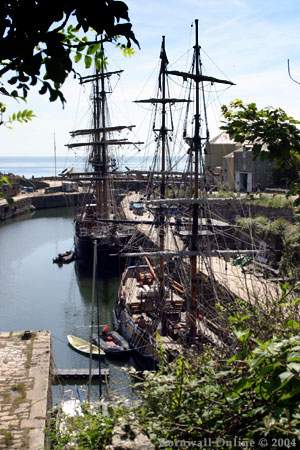
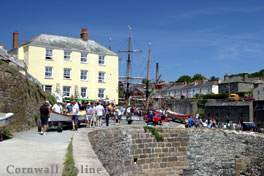
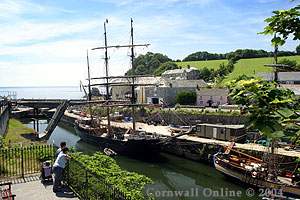
View across Charlestown harbour - from The Shipwrech centre
The second is that - again, against all the odds - it has largely escaped 'development' and remains one of the finest and most fascinating places on the Cornish coast.
Perhaps the words "so far" should be added to these two observations, for who knows what will happen to Charlestown in the future? At the time of writing, the harbour is the home port for a famous collection of old ships which are employed in film projects all over the world - they have brought work and life to the quays and harbour buildings and are a particular draw for visitors.

The beach and entrance to Charlestown Harbour | The Charlestown Shipwrek Museum
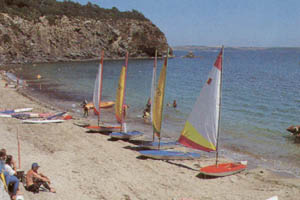
Porthpean Beach Is an ideal local spot for family days at the beach, Parking, Toilets and cafe available on the small beach front. The sands are ideal for family days out, swimming, snorkeling or Rock pooling
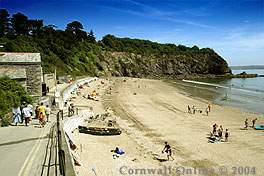
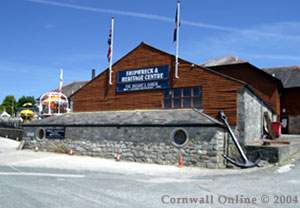
Charlestown Shipwreck and Heritage Centre
Located in a historic china clay building, the centre has the
largest U.K. collection of artifacts and treasure recovered
from shipwrecks.
Charlestown Shipwreck and Heritage Centre. Quay Road Charlestown Tel: +44 (0)1726 698 97
Quay Road Charlestown
Tel: +44 (0)1726 698 97
Charlestown's Centre commemorates achievement and heartbreak in a unique 18th century setting barely touched by time.
The achievement belongs to one man, Charles Rashleigh, whose vision created a thriving port out of an obscure fishing village. His reasons are, literally, a part of the Centre, which is built over the tunnels of an old China Clay "Dry". Down these - as you can see today - stevedores pushed wagons full of Cornwall's "white gold" to waiting ships.
The activity and facilities generated other trade
- in pilchards, stone, tin, copper ore, timber and coal - and with
it, a large commercial infrastructure.
Full-scale tableaux in the ' Heritage section show a cooper, blacksmith
and others at work, drawn to Charlestown by the magnet of trade.
In the Audio Visual Theatre you can see the saga unfold, from the
optimism of the 1791 blueprint, through a century of growth to recession
and decline at its end.
The Shipwreck section flips the coin of enterprise to show the forces it cannot control. Round Britain's coasts are over 250,000 wrecks, many with stories of courage and cowardice, greed or sacrifice to tell. The Centre shows a rich sample, in photography and wreckage or salvaged cargo: here, a 400-year old cannon; there, priceless Nanking porcelain: the artefacts recovered from the tragic sinking of HMS Ramillies in 1763, and - in a unique display - the history of underwater exploration, from the original wooden diving barrels to the latest 'bell".
Fittingly, the Centre's latest addition emphasises the saving of life at sea. While remaining fully operational, the Lifeboat "Aurelia" is on display for all to see how the RNLI volunteers face the elements.
Cornwall Online has 5 properties this area

 Lantern Cottage is a cosy 2 bedroom cottage next door to Courtyard Cottage. The Cottage benefits from a lovely decking area with barbecue.Master bedroom with kingsize bed and double bedroom with two single beds. located just 200 meters from the harbour and only 20 meters from the car park. The Cottage is perfect for families to explore all that Cornwall has to offer with beaches, coastal walks and the Lost Gardens of Heligan only minutes away - sleeps 4 people
Lantern Cottage is a cosy 2 bedroom cottage next door to Courtyard Cottage. The Cottage benefits from a lovely decking area with barbecue.Master bedroom with kingsize bed and double bedroom with two single beds. located just 200 meters from the harbour and only 20 meters from the car park. The Cottage is perfect for families to explore all that Cornwall has to offer with beaches, coastal walks and the Lost Gardens of Heligan only minutes away - sleeps 4 people
Sleeps:
4 max.
Location: Mevagissey
Nearest Beach:
0-1 mile
Saturday Changeover
Lantern Cottage
Facilities available at Lantern Cottage: Online Availability Parking Available Internet Access Towels Provided Linen Provided Cot Provided

 Fabulous and quiet, Tregrehan Garden Cottages lie within the stunning Cornish Estate since 1565 of the Carlyon family and one of the Great Gardens of Cornwall. Five holiday cottages are ideally located between Fowey and Charlestown, and under a mile from the beach and the Eden Project.
Fabulous and quiet, Tregrehan Garden Cottages lie within the stunning Cornish Estate since 1565 of the Carlyon family and one of the Great Gardens of Cornwall. Five holiday cottages are ideally located between Fowey and Charlestown, and under a mile from the beach and the Eden Project.
Open all year with high season prices from £520 to £1526 (sleeping 7)
Tregrehan Garden Cottages has Limited Disabled Facilities, please call 01726 812438 for details.
Sleeps:
7 max.
Location: St Austell
Nearest Beach:
0-1 mile
SHORT BREAKS AVAILABLE
Tregrehan Garden Cottages
01726 812438
Limited Disabled Facilities
Facilities available at Tregrehan Garden Cottages: Online Availability Credit/Debit Cards Accepted Pets Welcome Parking Available Internet Access En-Suite Facilities Towels Provided Linen Provided

 Rescorla Farm House is nestled in the peace of the countryside and commands stunning views- With ample on site parking Rescorla Farm is ideally located within walking distance of the Eden Project and short drives to local wineries; Fowey; The Lost Gardens of Heligan; Lanhydrock House and gardens; Bodmin Jail Museum and steam railway; Wheal Martyn China Clay Heritage Centre; Screech Owl Sanctuary; The Camel Trail (bike hire available); The Pine Lodge Gardens and Charlestown Shipwreck Heritage Centre.
Rescorla Farm House is nestled in the peace of the countryside and commands stunning views- With ample on site parking Rescorla Farm is ideally located within walking distance of the Eden Project and short drives to local wineries; Fowey; The Lost Gardens of Heligan; Lanhydrock House and gardens; Bodmin Jail Museum and steam railway; Wheal Martyn China Clay Heritage Centre; Screech Owl Sanctuary; The Camel Trail (bike hire available); The Pine Lodge Gardens and Charlestown Shipwreck Heritage Centre.
Sleeps:
6 max.
Location: St Austell
Nearest Beach:
3-10 miles
Rescorla Farmhouse
01726 851669
07598 791509
Facilities available at Rescorla Farmhouse: Online Availability Parking Available Internet Access En-Suite Facilities Towels Provided Linen Provided

 Holidays Cottages on the cornish Coast - enjoy a break in a stunning Cornish coastal location - explore the beautiful beaches and coves of the Cornish Coast
Holidays Cottages on the cornish Coast - enjoy a break in a stunning Cornish coastal location - explore the beautiful beaches and coves of the Cornish Coast
Port Isaac, Mawgan Porth, Padstow, Constantine, treyarnon bay, Rock polzeath, Tintagel,Porth, mawgan Porth Crackington Haven Penzance Newquay
Sleeps:
10+ max.
Suitable
for Large Groups
Location: cornwall
Nearest Beach:
0-1 mile
SHORT BREAKS AVAILABLE
Cornish Seaview Cottages by the sea
01428 723819
Facilities available at Cornish Seaview Cottages by the sea: Online Availability Parking Available Internet Access Sea Views

 The Old Shop Apartment is a self-contained one bedroom ground floor apartment sleeping two/four people. With all of the rooms on the ground floor, this property is ideal for anyone who prefers not to use stairs and occasional wheelchair users. Sleeps 2 + 2
The Old Shop Apartment is a self-contained one bedroom ground floor apartment sleeping two/four people. With all of the rooms on the ground floor, this property is ideal for anyone who prefers not to use stairs and occasional wheelchair users. Sleeps 2 + 2
Sleeps:
4 max.
Location: Mevagissey
Nearest Beach:
0-1 mile
Saturday Changeover
The Old Shop Apartment
Facilities available at The Old Shop Apartment: Online Availability

Cornwall Online | Looe| Talland Bay | Polperro | Polruan | Fowey | Lostwithiel | Mevagissey | Whitsandbay & The Rame Peninsula | Kingsand | Cawsand | Mount Edgecumbe Country Park | Torpoint | St Germans | Saltash | Liskeard | Siblyback Lake - Water Park | Minions - Bodmin Moor | St Neot | St Cleer | Callington | Gunnislake | Calstock | Cardinham Woods -Walking & Cycle Trails | Launceston | Plymouth